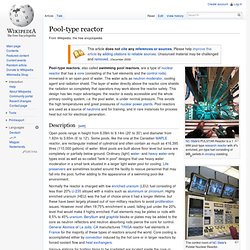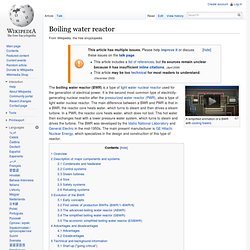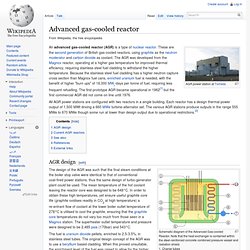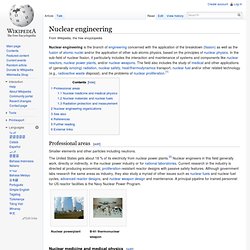

Fukushima. Nuclear - Japan. Seism in Japan. Nuclear industry. Nuclear orginizatiojs. Nuclear blogs. Nuclear reactor types - Search results. Light water reactor - Wiki. AP1000 Nuclear Reactor. Pool-Type Reactor - Wiki. The control room of NC State's Pulstar Nuclear Reactor.

Pool-type reactors, also called swimming pool reactors, are a type of nuclear reactor that has a core (consisting of the fuel elements and the control rods) immersed in an open pool of water. The water acts as neutron moderator, cooling agent and radiation shield. The layer of water directly above the reactor core shields the radiation so completely that operators may work above the reactor safely. This design has two major advantages: the reactor is easily accessible and the whole primary cooling system, i.e. the pool water, is under normal pressure. This avoids the high temperatures and great pressures of nuclear power plants. Description[edit] Open pools range in height from 6.09m to 9.14m (20' to 30') and diameter from 1.82m to 3.65m (6' to 12'). Normally the reactor is charged with low enriched uranium (LEU) fuel consisting of less than 20% U-235 alloyed with a matrix such as aluminium or zirconium. Applications[edit] Boiling water reactor.
The boiling water reactor (BWR) is a type of light water nuclear reactor used for the generation of electrical power.

It is the second most common type of electricity-generating nuclear reactor after the pressurized water reactor (PWR), also a type of light water nuclear reactor. The main difference between a BWR and PWR is that in a BWR, the reactor core heats water, which turns to steam and then drives a steam turbine. In a PWR, the reactor core heats water, which does not boil. This hot water then exchanges heat with a lower pressure water system, which turns to steam and drives the turbine.
List of nuclear reactors - Wiki. Advanced gas-cooled reactor - Wiki. An advanced gas-cooled reactor (AGR) is a type of nuclear reactor.

These are the second generation of British gas-cooled reactors, using graphite as the neutron moderator and carbon dioxide as coolant. The AGR was developed from the Magnox reactor, operating at a higher gas temperature for improved thermal efficiency, requiring stainless steel fuel cladding to withstand the higher temperature. Because the stainless steel fuel cladding has a higher neutron capture cross section than Magnox fuel cans, enriched uranium fuel is needed, with the benefit of higher "burn ups" of 18,000 MWt-days per tonne of fuel, requiring less frequent refuelling. The first prototype AGR became operational in 1962[1] but the first commercial AGR did not come on line until 1976. All AGR power stations are configured with two reactors in a single building. AGR design[edit] Sodium - Wiki. Sodium is a chemical element with the symbol Na (from Latin: natrium) and atomic number 11.

It is a soft, silver-white, highly reactive metal and is a member of the alkali metals; its only stable isotope is 23Na. The free metal does not occur in nature, but instead must be prepared from its compounds; it was first isolated by Humphry Davy in 1807 by the electrolysis of sodium hydroxide. Sodium is the sixth most abundant element in the Earth's crust, and exists in numerous minerals such as feldspars, sodalite and rock salt (NaCl).
Many salts of sodium are highly water-soluble, and their sodium has been leached by the action of water so that sodium and chlorine (Cl) are the most common dissolved elements by weight in the Earth's bodies of oceanic water. Many sodium compounds are useful, such as sodium hydroxide (lye) for soap-making, and sodium chloride for use as a de-icing agent and a nutrient (edible salt). Characteristics Physical Chemical Isotopes Occurrence Compounds Aqueous solutions. Fast-neutron reactor - Wiki. Shevchenko BN350 nuclear fast reactor and desalination plant situated on the shore of the Caspian Sea.

The plant generated 135 MWe and provided steam for an associated desalination plant. View of the interior of the reactor hall. A fast neutron reactor or simply a fast reactor is a category of nuclear reactor in which the fission chain reaction is sustained by fast neutrons. Such a reactor needs no neutron moderator, but must use fuel that is relatively rich in fissile material when compared to that required for a thermal reactor. Introduction[edit] Neutrons released in fission events typically have energies greater than 1 MeV. CANDU Reactor - Wiki. The CANDU (short for CANada Deuterium Uranium) reactor is a Canadian-invented, pressurized heavy water reactor.

The acronym refers to its deuterium-oxide (heavy water) moderator and its use of (originally, natural) uranium fuel. CANDU reactors were first developed in the late 1950s and 1960s by a partnership between Atomic Energy of Canada Limited (AECL), the Hydro-Electric Power Commission of Ontario (now Ontario Power Generation), Canadian General Electric (now GE Canada), and other companies. All power reactors built in Canada are of the CANDU type. The reactor is also marketed abroad and there are CANDU-type units operating in India, Pakistan, Argentina, South Korea, Romania and China. In October 2011, the Canadian Federal Government licensed the CANDU design to Candu Energy (a wholly owned subsidiary of SNC-Lavalin), which also acquired the former reactor development and marketing division of AECL at that time. Design[edit] Basic design and operation[edit] Safety features[edit]
Videos for education of nuclear engineering. Nuclear engineering. Nuclear engineering is the branch of engineering concerned with the application of the breakdown (fission) as well as the fusion of atomic nuclei and/or the application of other sub-atomic physics, based on the principles of nuclear physics.

In the sub-field of nuclear fission, it particularly includes the interaction and maintenance of systems and components like nuclear reactors, nuclear power plants, and/or nuclear weapons. The field also includes the study of medical and other applications of (generally ionizing) radiation, nuclear safety, heat/thermodynamics transport, nuclear fuel and/or other related technology (e.g., radioactive waste disposal), and the problems of nuclear proliferation.[1] Professional areas[edit] Smaller elements and other particles including neutrons. B-61 thermonuclear weapon Nuclear medicine and medical physics[edit] X-Ray Image of a male skullMagnetic Resonance Imaging scan of a headPET taken with an ECAT Exact HR+ PET Scanner See also[edit] References[edit]
Nuclear Energy vs. Global Warming. The Generation IV International Forum.